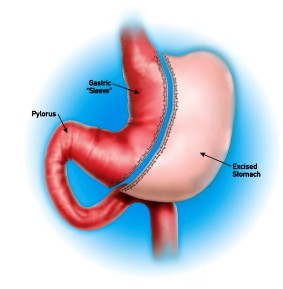Call us today!
The vertical sleeve gastrectomy, also known as the sleeve gastrectomy or gastric sleeve procedure, is an obesity surgery in which a portion of the stomach is removed. This results in a new, smaller stomach that is roughly the size and shape of a banana.

The sleeve gastrectomy works primarily by reducing the size of the stomach so the patient feels full after eating much less, takes in fewer calories, and loses weight. In addition, the surgery removes the portion of the stomach that produces a hormone that can make you feel hungry, so you don’t want to eat as much.
This procedure can be an excellent alternative to gastric bypass or gastric banding. Sleeve gastrectomy is a simpler operation than the gastric bypass procedure, because it doesn’t involve rerouting or reconnecting the intestines.
Also, unlike the gastric banding procedure, the sleeve gastrectomy doesn’t require the use of a banding device to be implanted around a portion of the stomach.
Our team will help you determine whether sleeve gastrectomy is appropriate for you and exactly how it will be performed.
Advantages of Sleeve Gastrectomy
- Fewer food intolerances than with the gastric band.
- Weight loss generally is faster with the sleeve than with the gastric band.
- There is no implantable band device, so slippage and erosion are not a risk.
- The surgical risk is lower than with the gastric bypass procedure, but the weight loss is similiar. In addition our team can perform the sleeve gastrectomy using minimally invasive techniques that help speed recovery time.
- No device that needs adjustment is inserted, so the follow-up regimen is not as intense as it would be with the band.
Disadvantages of Sleeve Gastrectomy
- Sleeve gastrectomy is non-adjustable and non-reversible, unlike gastric banding.
- Complications risks are slighly higher than with the band.
- Risks/Complications
- Standard risks associates with abdominal surgery performed under general anesthesia.
- Leakage at the suture/staple site.
- Blood clots (deep vein trombosis, pulmonary embolism), heart attack, stroke, pneumoni, bleeding, infection, death.
Recovery Timeline
- Most patients return to normal activity in two weeks.
- Full surgery recovery usually occurs in three weeks.




